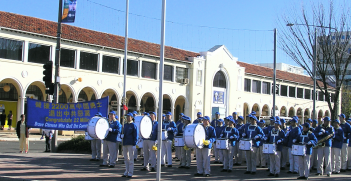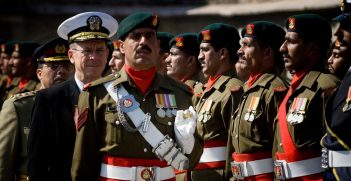Modi's Vision of the India-Australia Relationship: From Periphery to Centre

Dr Ashok Sharma reflects upon Indian PM Narendra Modi’s visit to Australia and the deepening of the India-Australia relationship.
Prime Minister Narendra Modi made an official visit to Australia from 16 – 18 November after the G20 summit. In addition to his participation in the summit, Modi’s interaction with scientists at Queensland University of Technology (QUT), his blockbuster reception in Sydney addressing a 20 000-strong crowd of Indian Diaspora, his address to the Australian Parliament and his meeting with top business leaders at the Australia-India Business Council in Melbourne, have been described widely as a transformation from the position of “International Pariah” to a “Political Rock Star”. The India-Australia relationship has moved well beyond a mutual fondness for cricket, as the two biggest naval powers of the Indian Ocean begin to forge a comprehensive bilateral relationship underpinning their sturdy economic, strategic and security partnership.
While addressing the Australian Parliament, Modi emphasised the synergy between the two countries as well as the challenges that both nations face. He noted the early completion of a deal committing Australia to sell uranium to India in which Australia agreed to export uranium, under suitable safeguards, to promote cleaner energy. In September 2014, PM Tony Abbott sealed negotiations for the export of Australian uranium to India; a deal that had been stalled due to India’s non-signatory status of Nuclear Non-Proliferation Treaty. Australia’s refusal to sell uranium to India was first relaxed with PM John Howard’s visit to India in 2006; a decision that was later overturned by Kevin Rudd’s Labor Government in 2009. Negotiations recommenced in 2011 after Julia Gillard’s Government lifted the ban on uranium sales. The current uranium deal will ensure India’s nuclear safety, address India’s looming energy crisis and enhance trade between the two countries. During his visit, India and Australia also signed five pacts concerning: social security, the transfer of sentenced prisoners, combating the narcotics trade, increasing tourism, and promoting arts and culture.
Elevating Economic Ties
The Modi-Abbott meeting also helped to deepen economic ties between India and Australia. While Modi prioritised Australia’s uranium sales to India, Abbott emphasised free trade, committing to a one-year timeline to sign a free trade agreement with what is potentially the world’s largest market. A free trade agreement with India would give Australian exporters access to a market of 1.25 billion people, including a middle class of around 500 million people in the coming years.
Abbott’s one-year timeline for a free trade deal with India is noteworthy because, just a day before, Australia signed a landmark free trade agreement with China more than ten years in the making. Australia-India trade stands at around $15 billion a year, just 1/10th of Australia-China trade. India and Australia are therefore keen to enhance the volume of their bilateral trade.
New Framework for Security Cooperation
In addition to economic negotiations, Modi and Abbott signed a Framework for Security Cooperation covering a number of policy areas including: maritime security, counter-terrorism, increased military exchanges and joint operations, technology transfers and border security. Both agreed to hold regular meetings at the level of Defence Minister, annual meetings of foreign policy leaders, and to convene a regular exchange of talks and meetings with all the three branches of the armed forces. They also decided to deepen their counter-terrorism cooperation since India has faced the threat of Islamic terrorism for more than three decades, while Australia is confronting a spurt of Islamic radicalisation in the country.
Great Game in Asia: The China factor
India and Australia share concerns about protecting the global commons, balancing against the rise of China and the resulting power shifts. Both nations seek to prevent Asia from being dominated by a single power despite the fact that China is also the largest trading partner of roughly 100 other nations, including India and Australia. Asian nations are forging alliances and partnerships with a strong military undertone. For example, Modi’s promise of greater cooperation on regional security contained an implied swipe at China over disputes with its neighbours regarding islands in the South China Sea. He said that peace and stability in the Asia-Pacific region could not be taken for granted and urged for India and Australia to collaborate in international forums to enhance universal respect for international law and global norms, particularly in the South China Sea. Australia also committed to supporting India’s campaign for a permanent seat in the UN Security Council. There is a mutual understanding that in addition to the US-led Asia-Pivot, India’s strategic presence in the region, and its strong relationship with other maritime democracies, will lead to a new regional security architecture that can forestall Chinese domination.
This security “framework” operates alongside Australia’s deepening “quasi-alliance” with Japan, Japan’s deepening defence ties with India, and the strengthening of ties between all three countries and the United States. The strategic partnership between India and Australia is enhanced by India’s growing closeness to the US, the US-Australia alliance, and the US Asia-Pivot. A significant decision illustrating orientation was the “Quadrilateral Initiative”, an idea which emerged after the naval exercise between the US, Japan, Australia and India during tsunami rescue operations and the Malabar naval exercise in 2007. This is an example of how like-minded governments in the Indo-Pacific region are forging strategic alliances as a concert of democracies.
Finally, one should note that Abbott was the Modi Government’s first state guest and that Modi is the first Indian Prime Minister to visit Australia in the last three decades. In the future, India will host summit level meetings between the prime minister’s of India and Australia annually, a gesture that India has extended only to Russia and Japan. India wants to achieve its rightful place in the world and the Modi government has taken concrete steps towards this, pursuing a host of economic and foreign policies in which Australian features prominently. Today, Australia is no longer confined to the periphery but has risen to the top tier of India’s foreign policy priorities.
Dr Ashok Sharma is an Honorary Academic in Politics and International Relations at the University of Auckland and Deputy Chair of New Zealand Institute of International Affairs, Auckland Branch.





